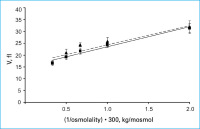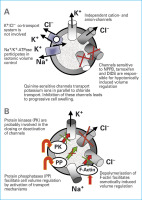Volume regulation
Abbildung 2: Mechanisms of volume regulation in mammalian spermatozoa (modified after [69]).
A. Transport mechanisms involved. Swelling-activated potassium and chloride channels are involved in osmotically induced volume regulation
in mammalian spermatozoa [68, 69]. Inhibition of chloride and potassium channels leads to restriction or loss of volume regulatory function. In contrast, inhibition of K+/Cl- co-transport or Na+/K+-ATPase has no negative effect on osmotically induced volume regulation though
these systems may be involved in isoosmotic volume regulation, together with other mechanisms related to sodium, potassium, chloride
and osmolyte transport. NPPB: 5-nitro-2-(3-phenylpropylamino)benzoic acid; DIDS: 4,4’-diisothiocyanatostilbene-2,2’-disulfonic acid. (These
and tamoxifen are all inhibitors of chloride channels.)
B. Putative modulation and signalling pathways of volume control. The activation, regulation or deactivation of transport mechanisms can be
mediated by modulation of F-actin and cytoskeletal integrity and/or by changes in phosphorylation/dephosphorylation balance (activity of protein kinases and phosphatases). Depolymerisation of F-actin facilitates
volume regulation; phosphorylation appears to be involved in the closing or deactivation of channels involved in volume regulation while
dephosphorylation leads to activation of ion transport mechanisms (probably chloride channels [68, 69]). Red arrows and lines: negative (inhibiting) action on transport and signalling mechanisms; green arrows and
lines: positive (accelerating) action.
Keywords:
Schema,
scheme,
spermatozoa,
Spermatozoen,
volume regulation,
Volumenregulation


